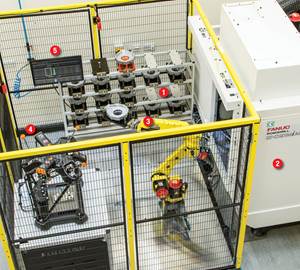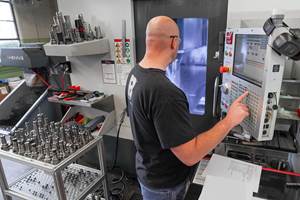Multi-Station Repeatability Enhances Quality For Complex Parts
Flexible automation is making production machining a new opportunity for shops that traditionally did not seek this kind of work. At the same time, automated machining systems are taking new shapes and configurations that favor this trend. A recently introduced example is the Turn 6 LC from ATS.
Share





Flexible automation is making production machining a new opportunity for shops that traditionally did not seek this kind of work. At the same time, automated machining systems are taking new shapes and configurations that favor this trend. A recently introduced example is the Turn 6 LC from Automation Tooling Systems (ATS) of Cambridge, Ontario. According to the company, this model offers multi-station CNC turning and machining in a completely new format. This medium- to high-volume machining technology combines up to six CNC precision chucking spindles, mounted on a "Hirth coupling" main indexing rotary transfer table. The system performs five-sided machining (turning, milling, drilling and tapping) for complete part production. Most operations require only a single clamping.
Apparently, the development of this system was driven by market need, specifically the ability to combine multiple turning and machining processes on one machine. Jeff Palser, sales and marketing manager for ATS Machine Tool Division, explains that the new machine fills a niche in the "chucking" machining market for companies that produce complex components in high volume, from bar stock, castings or forgings. "In applications typically requiring several dedicated CNC cells, this technology offers enormous advantages in productivity and cost," he claims. In addition, he says, because of the "clamp once" repeatability the machine can deliver, it offers final part quality that is very difficult to attain with conventional equipment linked with in-line transfer automation.
Using an indexing dial as a starting point, ATS configured the new machine around a central "Hirth coupling" main index table, incorporating as many as six motorized chucking spindles mounted on the servodriven rotary transfer unit. This configuration is designed to optimize both the station-to-station transfer cycle and accuracy.
The machine can be set up for either manual or automated load/unload at the first station, while the remaining five spindles are simultaneously in cut. According to Mr. Palser, this approach helps keep "chip-to-chip" times very low. Flexibility in tooling and CNC control allows many workpieces to be machined on five sides, with no secondary operations required. Because the workpiece is clamped only once, location and orientation are maintained from station to station.
Each station is equipped with modular two-axis CNC units, with a work envelope as large as 8 inches. Tooling options include single or twin horizontal/vertical tool spindles, multi-tool turrets and conventional toolholders. The machine can perform both on-center and off-center machining operations. CNC capability allows for single-point machining of complex forms, grooves or undercuts using conventional turning tools and G-code programming logic. Infinitely variable positioning through 360 degrees on the C axis facilitates accurate off-center milling, drilling or tapping processes. In addition, enhanced concentricity can be achieved by rotating both the workpiece and the cutting tool. Counter-rotating spindles can be employed to achieve high cutting speeds during light-cut finishing operations.
The tool spindle motors, nominally rated at 5 kW, are mounted on dual-axis servo controlled CNC slide units. The tool spindles are synchronized with the chuck spindles, rated at 12 kW. This arrangement facilitates polygon turning and on-the-fly part swapping to a secondary spindle in applications where double endwork is required. All spindles are independently servo controlled for speeds from 0 to 10,000 rpm, allowing feeds and speeds to be matched to each process step.
Options for this machine include high-pressure through-spindle coolant, a variety of load/unload material handling automation and active tool monitoring. Procedural training manuals are available online through the machine control.
Related Content
Lean Approach to Automated Machine Tending Delivers Quicker Paths to Success
Almost any shop can automate at least some of its production, even in low-volume, high-mix applications. The key to getting started is finding the simplest solutions that fit your requirements. It helps to work with an automation partner that understands your needs.
Read More3 Ways Artificial Intelligence Will Revolutionize Machine Shops
AI will become a tool to increase productivity in the same way that robotics has.
Read More5 Stages of a Closed-Loop CNC Machining Cell
Controlling variability in a closed-loop manufacturing process requires inspection data collected before, during and immediately after machining — and a means to act on that data in real time. Here’s one system that accomplishes this.
Read MoreMedical Shop Performs Lights-Out Production in Five-Axes
Moving to five-axis machining enabled this shop to dramatically reduce setup time and increase lights-out capacity, but success relied on the right combination of workholding and automation.
Read MoreRead Next
AMRs Are Moving Into Manufacturing: 4 Considerations for Implementation
AMRs can provide a flexible, easy-to-use automation platform so long as manufacturers choose a suitable task and prepare their facilities.
Read MoreMachine Shop MBA
Making Chips and Modern Machine Shop are teaming up for a new podcast series called Machine Shop MBA—designed to help manufacturers measure their success against the industry’s best. Through the lens of the Top Shops benchmarking program, the series explores the KPIs that set high-performing shops apart, from machine utilization and first-pass yield to employee engagement and revenue per employee.
Read More




















